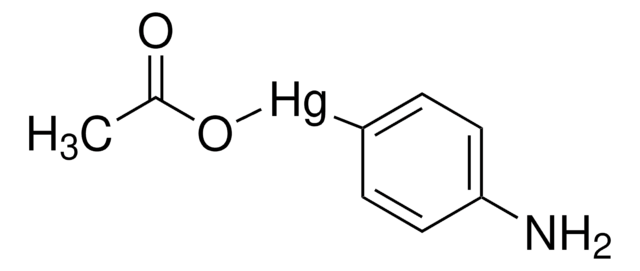N7009
2-Nitro-5-thiocyanatobenzoic acid
≥98% (HPLC)
Sinónimos:
2-Nitro-5-thiocyanobenzoic acid, NTCB
About This Item
Productos recomendados
product name
2-Nitro-5-thiocyanatobenzoic acid, powder
Análisis
≥98% (HPLC)
Nivel de calidad
formulario
powder
color
yellow
mp
156-157 °C (lit.)
temp. de almacenamiento
2-8°C
cadena SMILES
OC(=O)c1cc(SC#N)ccc1[N+]([O-])=O
InChI
1S/C8H4N2O4S/c9-4-15-5-1-2-7(10(13)14)6(3-5)8(11)12/h1-3H,(H,11,12)
Clave InChI
NQUNIMFHIWQQGJ-UHFFFAOYSA-N
¿Está buscando productos similares? Visita Guía de comparación de productos
Aplicación
- Site-Specific Conversion of Cysteine in a Protein to Dehydroalanine Using 2-Nitro-5-thiocyanatobenzoic Acid: This research demonstrates the use of 2-Nitro-5-thiocyanatobenzoic acid in protein engineering to modify cysteine residues, which is critical for developing therapeutic proteins and understanding protein structure-function relationships (Qiao et al., 2021).
- Scrapie prion protein structural constraints obtained by limited proteolysis and mass spectrometry: Highlights the utility of 2-Nitro-5-thiocyanatobenzoic acid in the study of prion proteins, providing insights into protein misfolding diseases which can lead to novel therapeutic approaches (Sajnani et al., 2008).
- Localization of a substrate binding domain of the human reduced folate carrier to transmembrane domain 11 by radioaffinity labeling and cysteine-substituted accessibility methods: Utilizes 2-Nitro-5-thiocyanatobenzoic acid in biochemical assays to understand transporter proteins, essential for drug delivery and targeting (Hou et al., 2005).
- A novel procedure for the preparation of biologically active recombinant peptides using a cyanylation reaction: Describes a method using 2-Nitro-5-thiocyanatobenzoic acid for peptide synthesis, beneficial for the development of peptide-based pharmaceuticals (Koyama et al., 1994).
Acciones bioquímicas o fisiológicas
Envase
Palabra de señalización
Warning
Frases de peligro
Consejos de prudencia
Clasificaciones de peligro
Eye Irrit. 2 - Skin Irrit. 2 - STOT SE 3
Órganos de actuación
Respiratory system
Código de clase de almacenamiento
11 - Combustible Solids
Clase de riesgo para el agua (WGK)
WGK 3
Punto de inflamabilidad (°F)
Not applicable
Punto de inflamabilidad (°C)
Not applicable
Equipo de protección personal
dust mask type N95 (US), Eyeshields, Gloves
Certificados de análisis (COA)
Busque Certificados de análisis (COA) introduciendo el número de lote del producto. Los números de lote se encuentran en la etiqueta del producto después de las palabras «Lot» o «Batch»
¿Ya tiene este producto?
Encuentre la documentación para los productos que ha comprado recientemente en la Biblioteca de documentos.
Los clientes también vieron
Nuestro equipo de científicos tiene experiencia en todas las áreas de investigación: Ciencias de la vida, Ciencia de los materiales, Síntesis química, Cromatografía, Analítica y muchas otras.
Póngase en contacto con el Servicio técnico









